Design of Heat-Pump Systems for Single- and Multi-Family Houses using a Heuristic Scheduling for the Optimization of PV Self-Consumption
Abstract
1. Introduction
2. Literature
3. Methodology
3.1. Reference Buildings and Demand Data
- Construction before 1979.
- Construction between 1979 and 2001.
- Construction between 2002 and 2015.
- Construction after 2015.
3.2. Heat-Pump System
3.3. PV Plant and Battery
3.4. Simulation Model
4. Results
4.1. Variation of Thermal Energy Storage (TES) volume
4.2. Variation of Heat-Pump Size
4.3. Summary for Reference Buildings
4.4. Increasing Self-Sufficiency Level (SSL) by Adding a Battery Storage
5. Conclusions
Author Contributions
Funding
Conflicts of Interest
Abbreviations
| Abbreviation | Description |
| AWHP | Air-water heat pump |
| BWHP | Brine-water heat pump |
| DHW | Domestic hot water |
| EH | Electric heater |
| HP | Heat pump |
| IC | Internal control |
| MFH | Multi-family house |
| SFH | Single-family house |
| SPF | Seasonal performance factor |
| SSL | Self-sufficiency level |
| TES | Thermal energy storage |
Appendix A
| SFH | MFH | |||||||
|---|---|---|---|---|---|---|---|---|
| Category 1 Before 1979 | Category 2 1979–2001 | Category 3 2002–2015 | Category 4 After 2015 | Category 1 Before 1979 | Category 2 1979–2001 | Category 3 2002–2015 | Category 4 After 2015 | |
| Heat demand 2020 [kWhth/a] | 7686 | 8553 | 9421 | 8160 | 43,135 | 31,716 | 25,255 | 9568 |
| Heat demand 2050 [kWhth/a] | 6395 | 7558 | 8943 | 5366 | 23,718 | 23,993 | 20,252 | 5675 |
| DHW demand 2020 [kWhth/a] | 1514 | 1514 | 1514 | 1514 | 11,771 | 9367 | 7265 | 5340 |
| DHW demand 2050 [kWhth/a] | 1915 | 1514 | 1514 | 1514 | 10,581 | 8196 | 7015 | 5346 |
| El. Demand [kWhel/a] | 4000 | 16,000 | ||||||
| Heating system | Radiator system | Floor heating | Radiator system | Floor heating | ||||
| Supply|Return Temperature Heating System for 2020 [°C] | 55|35 | 35|25 | 55|35 | 35|25 | ||||
| Supply|Return Temperature Heating System for 2050 [°C] | 45|35 | 55|35 | 45|35 | 45|35 | 45|35 | 55|35 | ||
| Th. Power el. heater [kW] | 3 | 5 | ||||||
| Power Photovoltaik for 2020 [kWp] | 6 | 30 | 31 | 25 | 22 | |||
| Power Photovoltaik for 2050 [kWp] | 24 | 33 | 23 | 22 | ||||
References
- United Nations Framework Convention on Climate Change. The Paris Agreement|UNFCCC, 29 January 2016. Available online: https://unfccc.int/files/meetings/paris_nov_2015/application/vnd.openxmlformats-officedocument.wordprocessingml.document/cp10a1_en.docx (accessed on 8 January 2020).
- Intergovernmental Panel on Climate Change IPCC, Summary for Policymakers of IPCC Special Report on Global Warming of 1.5 °C approved by governments, 8 October 2018. Available online: https://www.ipcc.ch/2018/10/08/summary-for-policymakers-of-ipcc-special-report-on-global-warming-of-1-5c-approved-by-governments/ (accessed on 8 January 2020).
- Umweltbundesamt, Erneuerbare Energien in Zahlen, 15 March 2019. Available online: https://www.umweltbundesamt.de/themen/klima-energie/erneuerbare-energien/erneuerbare-energien-in-zahlen#statusquo (accessed on 24 October 2019).
- Akmal, M.; Fox, B. Modelling and Simulation of Underfloor Heating System Supplied from Heat Pump. In Proceedings of the UKSim-AMSS 18th International Conference on Computer Modelling and Simulation (UKSim), Cambridge, UK, 6–8 April 2016. [Google Scholar] [CrossRef]
- Allison, J.; Cowie, A.; Galloway, S.; Hand, J.; Kelly, N.; Stephen, B. Simulation, implementation and monitoring of heat pump load shifting using a predictive controller. Energy Convers. Manag. 2017, 150, 890–903. [Google Scholar] [CrossRef]
- Allouhi, A.; Boharb, A.; Jamil, A.; Msaad, A.A.; Benbassou, A.; Kousksou, T. Simulation of a thermoelectric heating system for small-size office buildings in cold climates. In Proceedings of the 3rd International Renewable and Sustainable Energy Conference (IRSEC), Marrakech, Morocco, 10–13 December 2015. [Google Scholar] [CrossRef]
- Jonas, D.; Frey, G. Model-based analysis of the performance and the environmental impact of solar thermal and heat pump systems. In Proceedings of the 9th International Renewable Energy Congress (IREC), Hammamet, Tunisia, 20–22 March 2018. [Google Scholar] [CrossRef]
- Mastouri, M.; Bouguila, N. A methodology for thermal modelling and predictive control for building heating systems. In Proceedings of the 18th International Conference on Sciences and Techniques of Automatic Control and Computer Engineering (STA), Monastir, Tunisia, 21–23 December 2017. [Google Scholar] [CrossRef]
- Péan, T.; Costa-Castelló, R.; Fuentes, E.; Salom, J. Experimental Testing of Variable Speed Heat Pump Control Strategies for Enhancing Energy Flexibility in Buildings. IEEE Access 2019, 7, 37071–37087. [Google Scholar] [CrossRef]
- Rimbala, J.; Votava, J.; Kyncl, J. Assessment of Energy Consumption in the Residential Building with a Heat Pump. In Proceedings of the 20th International Scientific Conference on Electric Power Engineering (EPE), Kouty nad Desnou, Czech Republic, 15–17 May 2019. [Google Scholar] [CrossRef]
- Song, L.; Meng, L.; Han, Y.; Fan, H.; Yin, X.; Gao, F.; Jiao, Y.; Liu, Y. Analysis of micro-grid integration with PV, energy storage and ground-source heat pump based on DeST simulation. In Proceedings of the IEEE Conference on Energy Internet and Energy System Integration (EI2), Beijing, China, 26–28 November 2017. [Google Scholar] [CrossRef]
- Tangwe, S.; Simon, M.; Meyer, E.L. Prediction of coefficient of performance and simulation design of an air source heat pump water heater. J. Eng. Des. Technol. 2017, 15, 378–394. [Google Scholar] [CrossRef]
- Verbruggen, B.; Driesen, J. Grid Impact Indicators for Active Building Simulations. IEEE Trans. Sustain. Energy 2015, 6, 43–50. [Google Scholar] [CrossRef]
- Rashid, K.; Mohammadi, K.; Powell, K. Dynamic simulation and techno-economic analysis of a concentrated solar power (CSP) plant hybridized with both thermal energy storage and natural gas. J. Clean. Prod. 2019. [Google Scholar] [CrossRef]
- Rashid, K.; Safdarnejad, S.M.; Ellingwood, K.; Powell, K.M. Techno-economic evaluation of different hybridization schemes for a solar thermal/gas power plant. Energy 2019, 181, 91–106. [Google Scholar] [CrossRef]
- Wärmeatlas Baden-Württemberg—Erstellung eines Leitfadens und Umsetzung für Modellregionen. Available online: https://fachdokumente.lubw.baden-wuerttemberg.de/servlet/is/90488/?COMMAND=DisplayBericht&FIS=203&OBJECT=90488&MODE=METADATA (accessed on 27 February 2020).
- Türk, S. Erzeugung Konsistenter Elektrischer und Thermischer Lastgänge Für Typische Ein- und Mehrfamilienhäuser; Internal document University of Stuttgart: Stuttgart, Germany, 2019. [Google Scholar]
- VDI. VDI 4655, Reference Load Profiles of Single-Family and Multi-Family Houses for the Use of CHP Systems. Available online: https://standards.globalspec.com/std/1090927/VDI%204655 (accessed on 20 February 2020).
- Born, H.; Schimpf-Willenbrink, S.; Lange, H.; Bussmann, G.; Bracke, R. Analyse des Deutschen Wärmepumpenmarktes—Bestandsaufnahme und Trends—2 Aktualisierung der Studie; International Geothermal Centre: Bochum, Germany, 2017. [Google Scholar]
- Kemmler, T.; Thomas, B. Simulation von Wärmepumpensystemen auf der Grundlage von Korrelationsfunktionen für die Leistungsdaten der Wärmepumpe. In Proceedings of the 16th Symposium Energieinnovation, Graz, Austria, 12–14 February 2020. [Google Scholar]
- Platt, M.; Exner, S.; Bracke, R. Analyse des Deutschen Wärmepumpenmarktes—Bestandsaufnahme und Trends; International Geothermal Centre: Bochum, Germany, 2010. [Google Scholar]
- Acker, U. Solaranlage. eu—Photovoltaik & Solarthermie, Christian Münch GmbH. Available online: https://www.solaranlage.eu/photovoltaik/technik-komponenten/solarmodule/kwp (accessed on 11 October 2019).
- Madel, A. Solaranlage Ratgeber, Anondi GmbH. Available online: https://www.solaranlage-ratgeber.de/photovoltaik/photovoltaik-planung/photovoltaikanlage-dimensionierung (accessed on 11 October 2019).
- Versionsarchiv-Dateien-sciebo. Available online: https://fh-aachen.sciebo.de/index.php/s/0hxub0iIJrui3ED?path=%2FVersionsarchiv (accessed on 27 February 2020).
- Widmann, C.; Lödige, D.; Toradmal, A.; Thomas, B. Enabling CHP units for electricity production on demand by smart management of the thermal energy storage. Appl. Therm. Eng. 2017, 114, 1487–1497. [Google Scholar] [CrossRef]
- Lödige, D.; Thomas, B.; Widmann, C. Stromoptimierter Betrieb von KWK-Anlagen Durch Intelligentes Wärmespeichermanagement, May 2016. Available online: http://fachdokumente.lubw.baden-wuerttemberg.de/servlet/is/118201/bwe13002_abschlussbericht.pdf?command=downloadContent&filename=bwe13002_abschlussbericht.pdf&FIS=203 (accessed on 10 February 2020).
- Toradmal, A.; Kemmler, T.; Thomas, B. Boosting the share of onsite PV-electricity utilization by optimized scheduling of a heat pump using buildings thermal inertia. Appl. Therm. Eng. 2018, 137, 248–258. [Google Scholar] [CrossRef]
- VDI. VDI 4650, Calculation of the Seasonal Coefficient of Performance of Heat Pumps. Available online: https://standards.globalspec.com/standards/detail?docId=13216340 (accessed on 20 February 2020).
- Gerlach, H.; Thomas, B. Künftige Auslegung von KWK-Anlagen: Flexibler Betrieb Statt Dauerlauf, HLH Lüftung/Klima/Heizung/Sanitär/Gebäudetechnik; VDI Fachmedien GmbH & Co. KG: Düsseldorf, Germany, 2019; pp. 20–24. [Google Scholar]
- Günther, D.; Miara, M.; Langner, R.; Helmling, S.; Wapler, J. WP Monitor—Die Ergebnisse. 2011. Available online: https://wp-monitoring.ise.fraunhofer.de/wp-monitor-plus/download/endbericht_wp_monitor_klein.pdf (accessed on 10 February 2020).
- Scon-Marketing GmbH, Solar-Akku: Preise, Kosten und Wirtschaftlichkeit. Available online: https://www.solaranlagen-portal.de/solar-akku/solar-akku-preise-kosten.html (accessed on 6 November 2019).
- DAA Deutsche Auftragsagentur GmbH, Solarstromspeicher: Preis für einen Photovoltaik Speicher, 3 June 2019. Available online: https://www.solaranlagen-portal.com/photovoltaik/stromspeicher/preise (accessed on 7 November 2019).
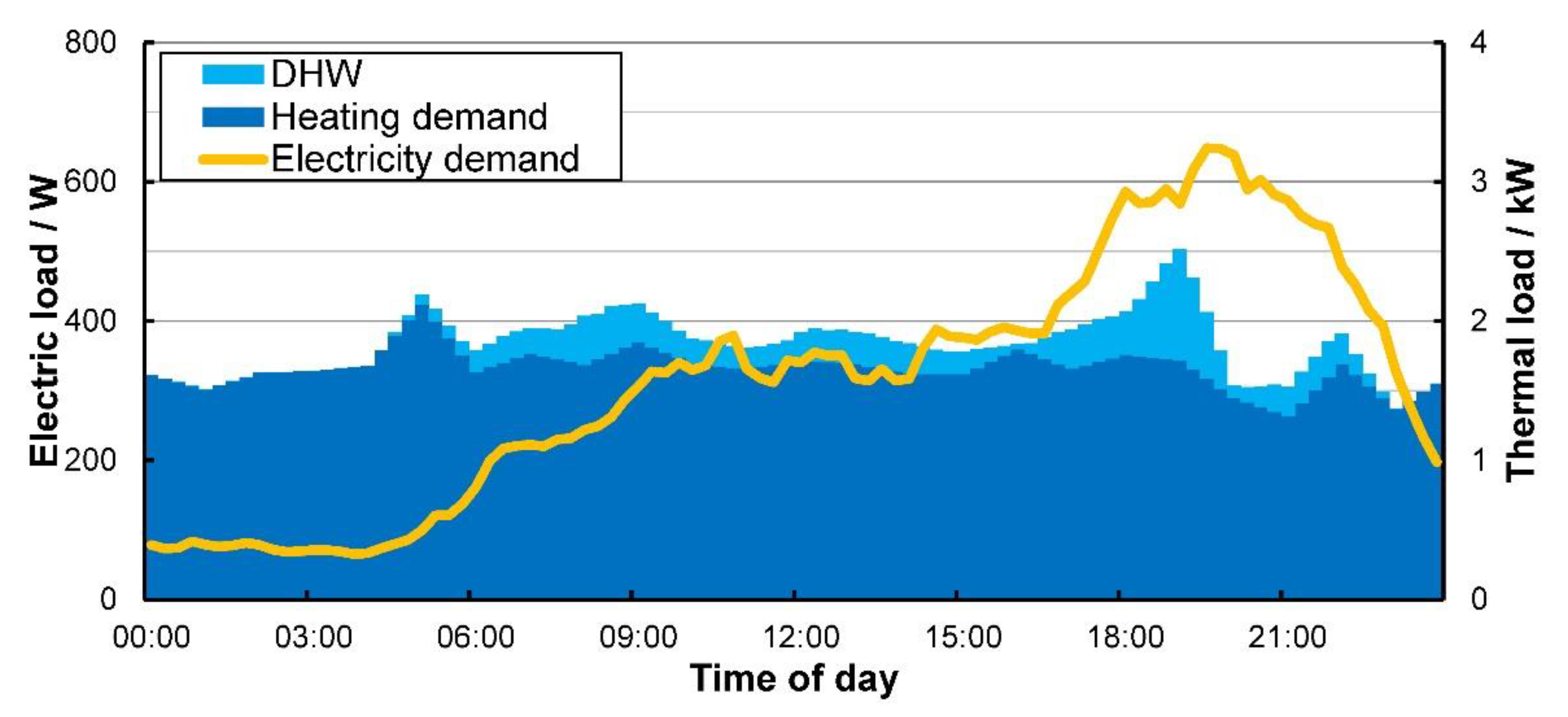
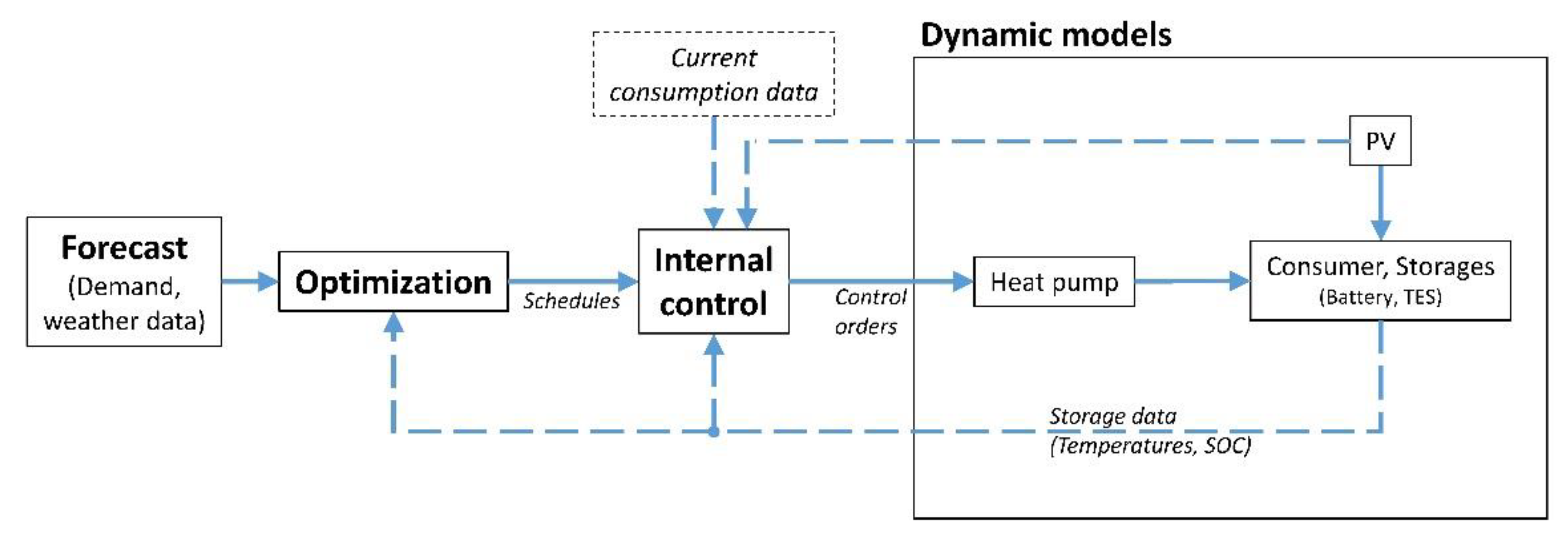

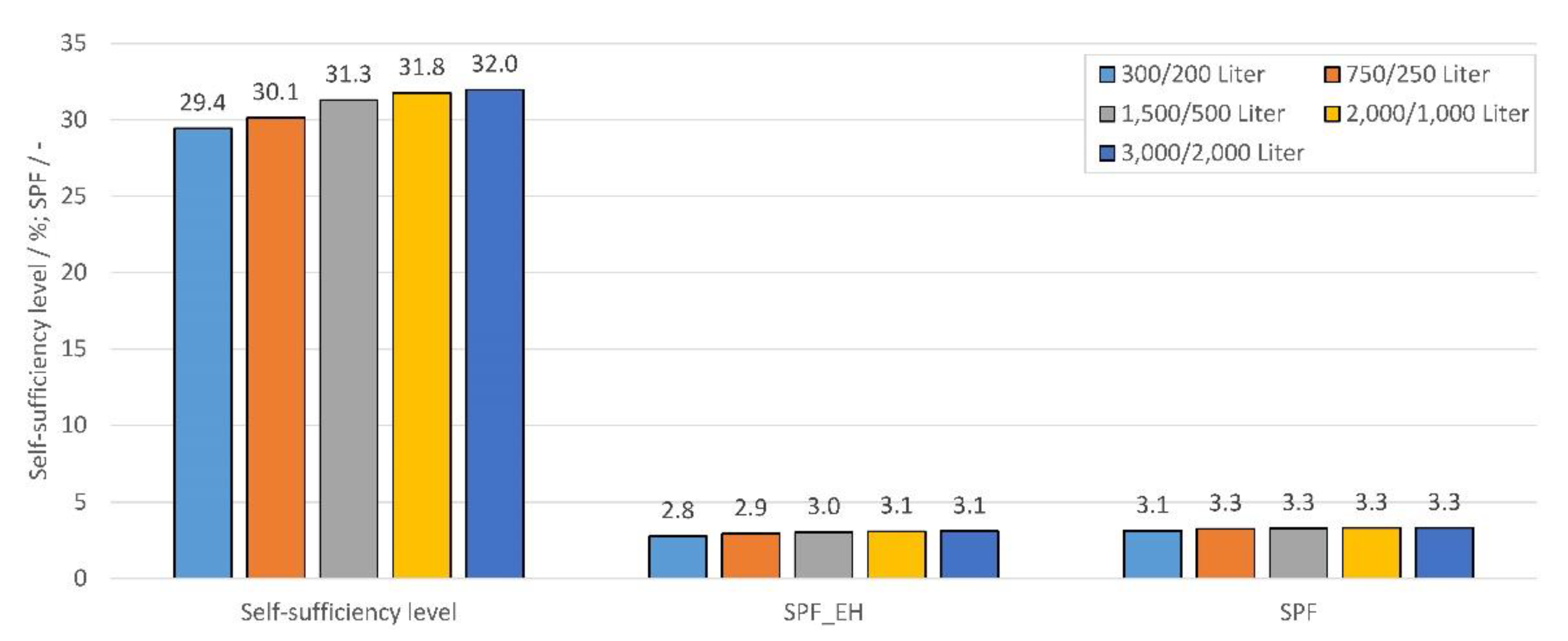
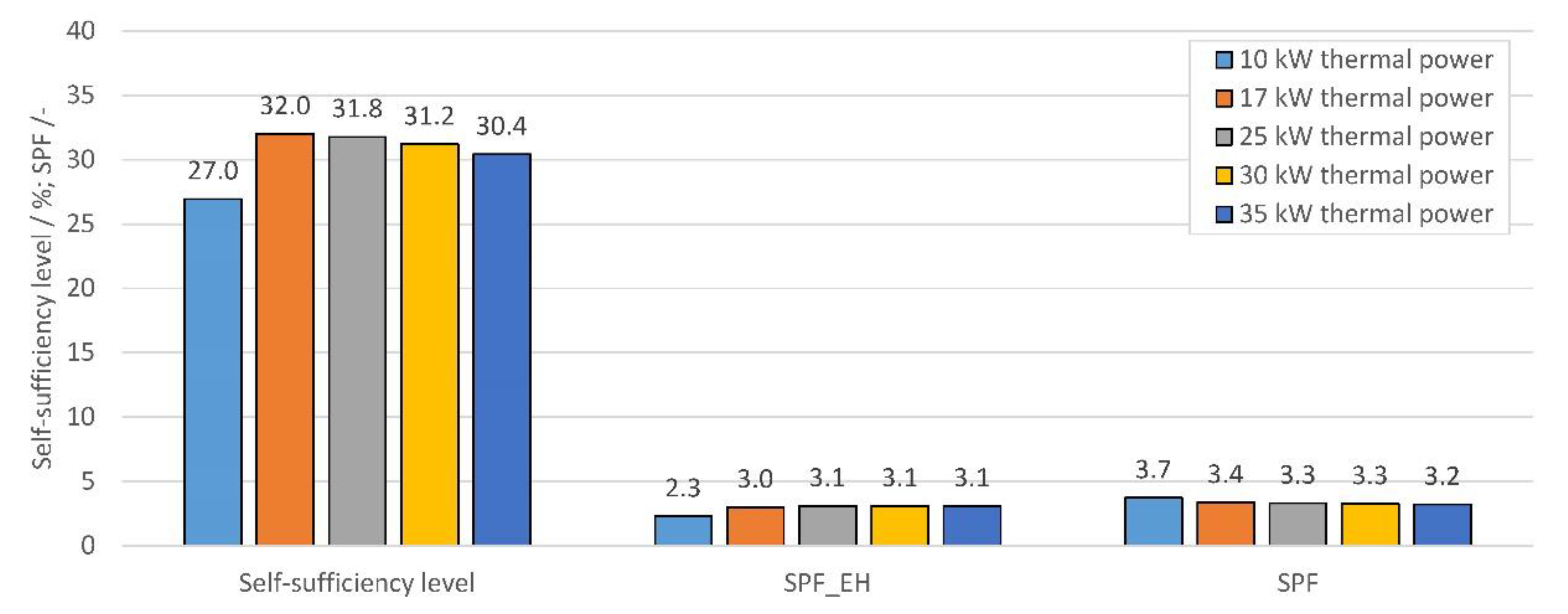
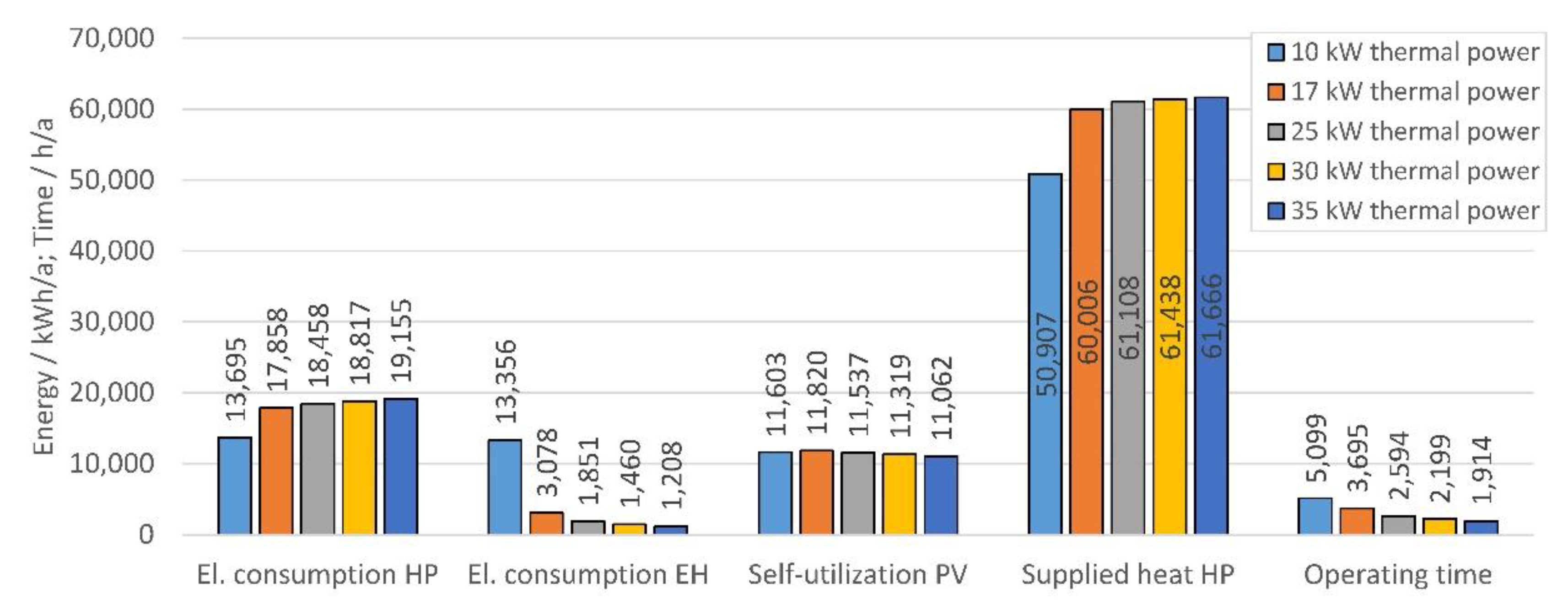
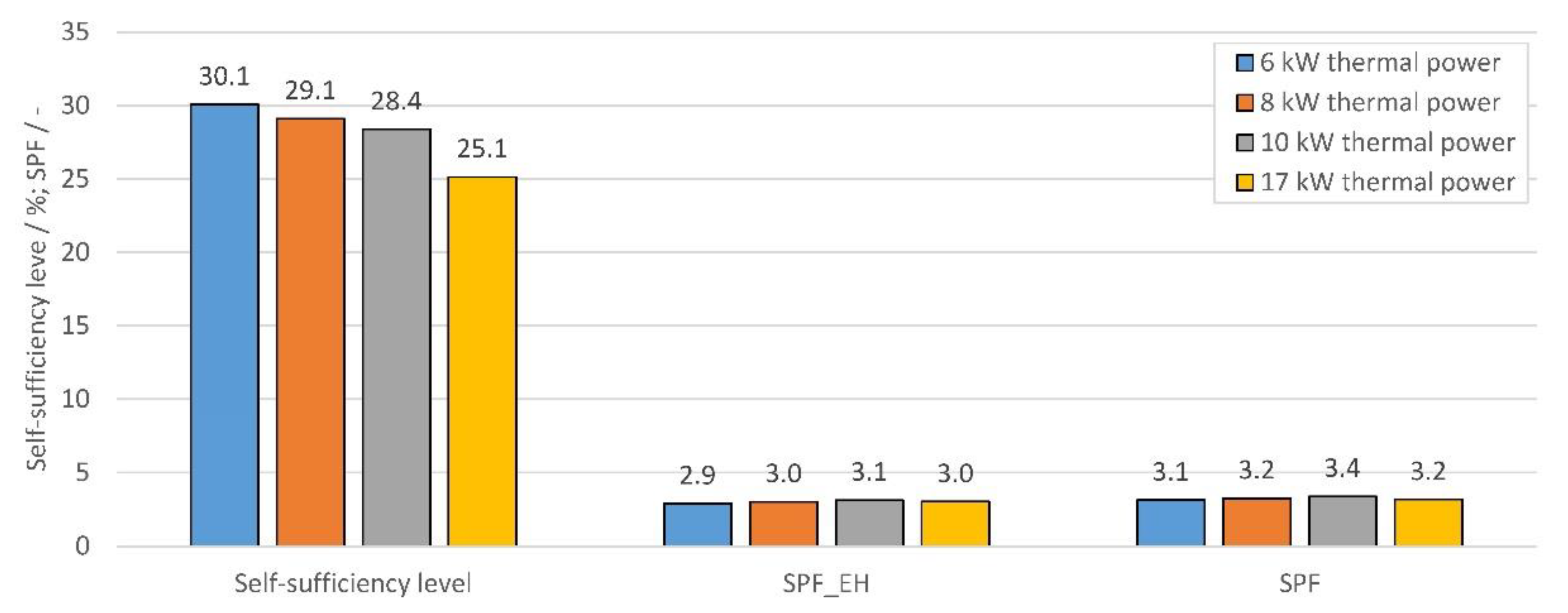
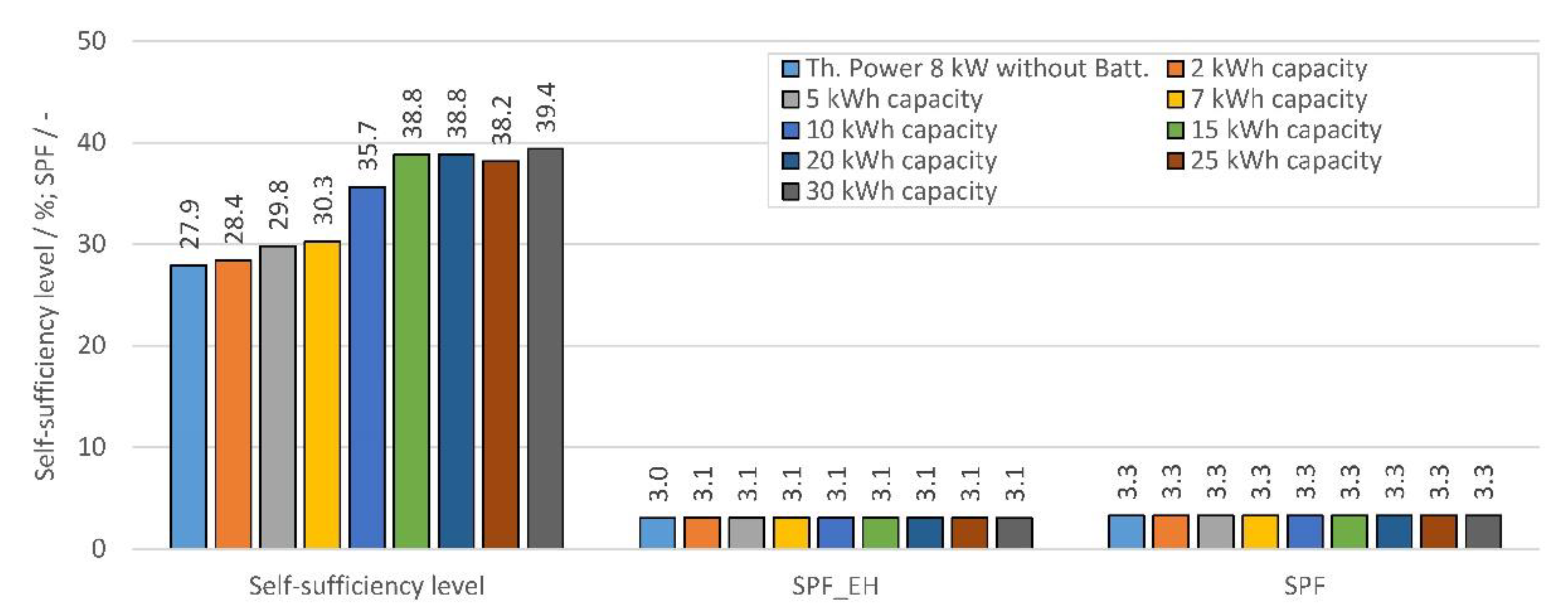
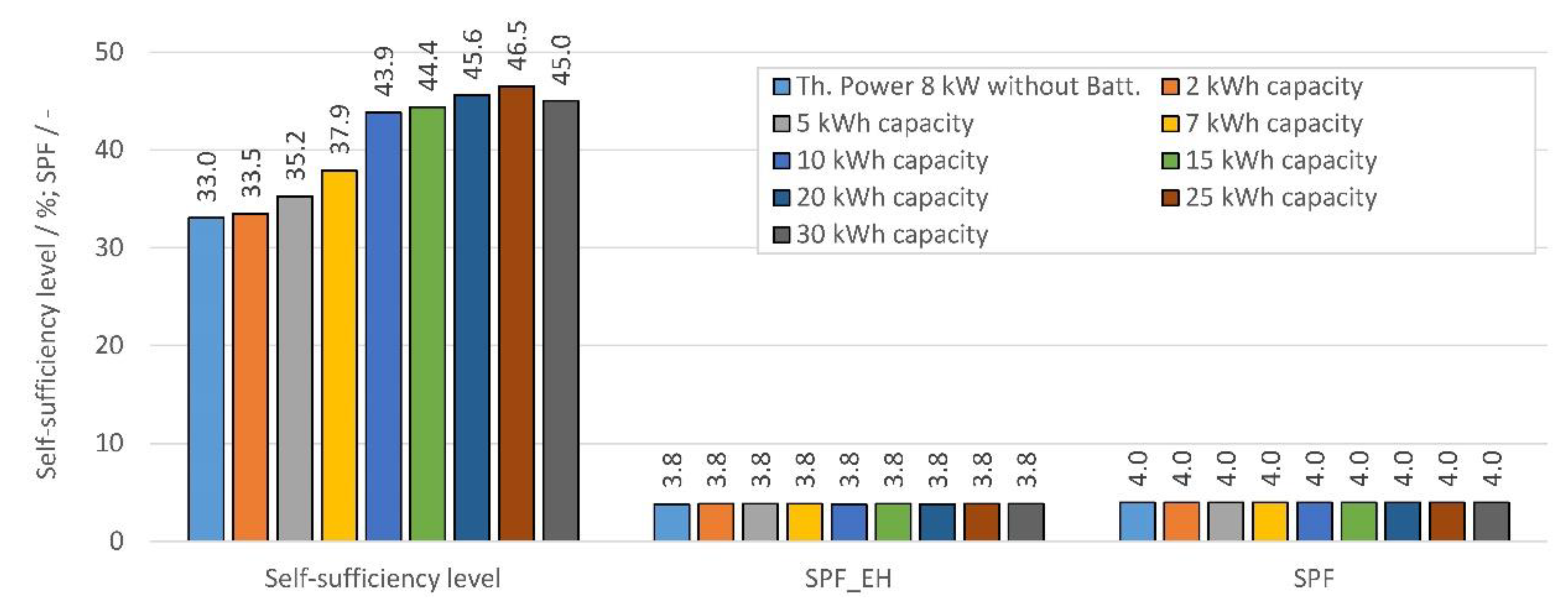
| 2020 | SFH BWHP | SFH AWHP | ||||||
| Category 1 Before 1979 | Category 2 1979–2001 | Category 3 2002–2015 | Category 4 After 2015 | Category 1 Before 1979 | Category 2 1979–2001 | Category 3 2002–2015 | Category 4 After 2015 | |
| Nominal Power HP/kW | 8 | 8 | 8 | 8 | 8 | 8 | 8 | 8 |
| Volume Heating TES/Liter | 600 | 600 | 600 | 600 | 600 | 600 | 600 | 600 |
| Volume DHW TES/Liter | 200 | 200 | 200 | 200 | 200 | 200 | 200 | 200 |
| SSL/% | 29.1 | 28.5 | 27.9 | 32.3 | 26.5 | 26.0 | 25.3 | 29.2 |
| SPF_EH/- | 3.0 | 3.0 | 3.0 | 3.9 | 2.4 | 2.4 | 2.4 | 2.9 |
| 2050 | SFH BWHP | SFH AWHP | ||||||
| Category 1 Before 1979 | Category 2 1979–2001 | Category 3 2002–2015 | Category 4 After 2015 | Category 1 Before 1979 | Category 2 1979–2001 | Category 3 2002–2015 | Category 4 After 2015 | |
| Nominal Power HP/kW | 8 | 8 | 8 | 8 | 8 | 8 | 8 | 8 |
| Volume Heating TES/Liter | 600 | 600 | 600 | 600 | 600 | 600 | 600 | 600 |
| Volume DHW TES/Liter | 200 | 200 | 200 | 200 | 200 | 200 | 200 | 200 |
| SSL/% | 31.2 | 29.8 | 29.9 | 34.3 | 28.9 | 27.4 | 27.3 | 31.6 |
| SPF_EH/- | 3.3 | 3.0 | 3.5 | 3.7 | 2.7 | 2.5 | 2.7 | 2.9 |
| 2020 | MFH BWHP | MFH AWHP | ||||||
| Category 1 Before 1979 | Category 2 1979–2001 | Category 3 2002–2015 | Category 4 After 2015 | Category 1 Before 1979 | Category 2 1979–2001 | Category 3 2002–2015 | Category 4 After 2015 | |
| Nominal Power HP/kW | 25 | 25 | 17 | 10 | 25 | 25 | 25 | 10 |
| Volume Heating TES/Liter | 2000 | 2000 | 2000 | 2000 | 2000 | 2000 | 2000 | 2000 |
| Volume DHW TES/Liter | 1000 | 1000 | 1000 | 1000 | 1000 | 1000 | 1000 | 1000 |
| SSL/% | 31.8 | 34.4 | 34.6 | 40.4 | 28.9 | 31.3 | 30.7 | 37.9 |
| SPF_EH/- | 3.1 | 3.1 | 3.0 | 3.5 | 2.7 | 2.7 | 2.7 | 2.9 |
| 2050 | MFH BWHP | MFH AWHP | ||||||
| Category 1 Before 1979 | Category 2 1979–2001 | Category 3 2002–2015 | Category 4 After 2015 | Category 1 Before 1979 | Category 2 1979–2001 | Category 3 2002–2015 | Category 4 After 2015 | |
| Nominal Power HP/kW | 10 | 10 | 10 | 8 | 17 | 17 | 10 | 10 |
| Volume Heating TES/Liter | 2000 | 2000 | 2000 | 600 | 2000 | 2000 | 2000 | 600 |
| Volume DHW TES/Liter | 1000 | 1000 | 1000 | 500 | 1000 | 1000 | 1000 | 500 |
| SSL/% | 36.7 | 40.4 | 36.4 | 41.0 | 33.3 | 36.4 | 33.3 | 39.5 |
| SPF_EH/- | 3.4 | 3.5 | 3.1 | 3.2 | 2.9 | 2.9 | 2.6 | 2.8 |
© 2020 by the authors. Licensee MDPI, Basel, Switzerland. This article is an open access article distributed under the terms and conditions of the Creative Commons Attribution (CC BY) license (http://creativecommons.org/licenses/by/4.0/).
Share and Cite
Kemmler, T.; Thomas, B. Design of Heat-Pump Systems for Single- and Multi-Family Houses using a Heuristic Scheduling for the Optimization of PV Self-Consumption. Energies 2020, 13, 1118. https://doi.org/10.3390/en13051118
Kemmler T, Thomas B. Design of Heat-Pump Systems for Single- and Multi-Family Houses using a Heuristic Scheduling for the Optimization of PV Self-Consumption. Energies. 2020; 13(5):1118. https://doi.org/10.3390/en13051118
Chicago/Turabian StyleKemmler, Thomas, and Bernd Thomas. 2020. "Design of Heat-Pump Systems for Single- and Multi-Family Houses using a Heuristic Scheduling for the Optimization of PV Self-Consumption" Energies 13, no. 5: 1118. https://doi.org/10.3390/en13051118
APA StyleKemmler, T., & Thomas, B. (2020). Design of Heat-Pump Systems for Single- and Multi-Family Houses using a Heuristic Scheduling for the Optimization of PV Self-Consumption. Energies, 13(5), 1118. https://doi.org/10.3390/en13051118





